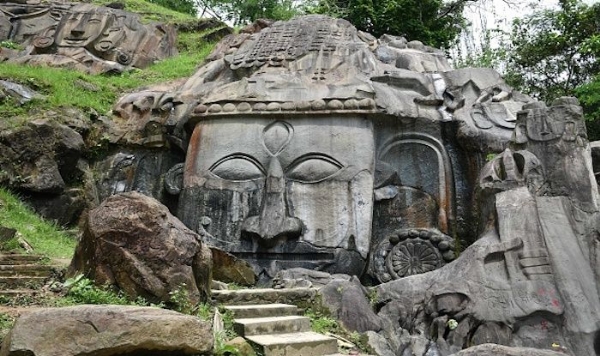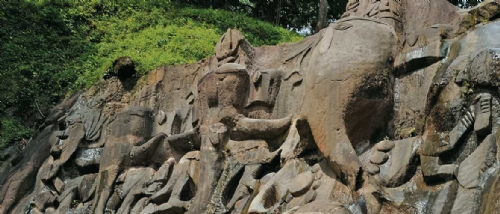Unakoti, the mystical lost hill of faces in Tripura!
The hill is camouflaged by the dense forests of Jampui hills and this stunning heritage site stands to be a known but now forgotten treasure of our country.
Total Views |
Our country is filled with mysterious places, the origins of whom we still aren't able to fully determine. Unakoti is a place just like that, and is no less than a wonder hidden in plain sight! Around 178 kilometres from Agartala in Unakoti district, Tripura, an ancient stone gate opens into huge stone sculptures carved into a hill. Bridges and broken staircases that run here between the slopes, lead to a 30-feet tall head of Lord Shiva, named Unakotiswara Kal Bhairava. This sculpture stands bordered by those of other goddesses, like Ganga sitting on a Capricorn and Durga standing on a lion.

There was a time, ages ago, when the land of Unakoti was a thriving as a pilgrimage. Streams and rivers flowed by the foothills here, and fragrant incense was detectable in the air. Back then, scores of believers thronged the site to seek blessings of the Lord. The place had been famous as a Shaivite pilgrimage site from the 8th or 9th century CE, until its gradual decline in the modern world.
The place has been crafted by expert artisans; the stone sculptures brought the region’s local legends to life. An annual celebration of the Ashokastami Mela every April is the one marker of its earlier importance.
However, none of the other gods apart from Lord Shiva himself woke up. Enraged by this, Lord Shiva unleashed his fury upon the lot and turned them all to stone, lending the site its name.
Another legend is associated with an artisan named Kallu Kumhar, who asked to accompany Parvati and Lord Shiva and their entourage on their journey to Mount Kailash. This was when Parvati suggested that he build 1,00,00,000 stone sculptures of Shiva and his company to appease the lord. The condition was that he had only one night to finish the job. Skilled at what he did, Kallu managed to make almost one crore sculptures, falling short by one.

History is woven into every sculpture here. The mysteries & legends here are embedded in all these sculptures - most of which are undiscovered till date. How many of these stand exposed? How many of them do you think hold sacred souls frozen in time ? Only a visit to the place can answer these questions.

The figures of Lord Hanumana, Lord Ganesha, Ravana and more deities from Hindu mythology are also present here and truly sculpted to literal perfection. The hill is camouflaged by the dense forests of Jampui hills and this stunning heritage site stands to be a known but now forgotten treasure of our country. It is called the ‘Lost Hill of Faces’ and as we saw, the name is apt for the place. The place is believed to be 11-13 centuries old.
In Tripura, the infrastructural developments are still gradually falling into place, but it is a distinguished area for a paradise-like region on the Jampui Hills of North Tripura.
There was a time, ages ago, when the land of Unakoti was a thriving as a pilgrimage. Streams and rivers flowed by the foothills here, and fragrant incense was detectable in the air. Back then, scores of believers thronged the site to seek blessings of the Lord. The place had been famous as a Shaivite pilgrimage site from the 8th or 9th century CE, until its gradual decline in the modern world.
The place has been crafted by expert artisans; the stone sculptures brought the region’s local legends to life. An annual celebration of the Ashokastami Mela every April is the one marker of its earlier importance.
Also Read | Kedareshwara Temple, the 12th century masterpiece of Hoysala empire
The word ‘Unakoti’ literally translates to less than one crore. The myth behind these carvings tells of Lord Shiva and his famous wrath. According to the story, on one of his trips to Kashi, Shiva was accompanied by as many as 99,99,999 gods and goddesses. They all spent a night at this location and were expected to awaken and make their way to the pilgrimage site before dawn.
However, none of the other gods apart from Lord Shiva himself woke up. Enraged by this, Lord Shiva unleashed his fury upon the lot and turned them all to stone, lending the site its name.
Another legend is associated with an artisan named Kallu Kumhar, who asked to accompany Parvati and Lord Shiva and their entourage on their journey to Mount Kailash. This was when Parvati suggested that he build 1,00,00,000 stone sculptures of Shiva and his company to appease the lord. The condition was that he had only one night to finish the job. Skilled at what he did, Kallu managed to make almost one crore sculptures, falling short by one.

While Unakoti became a major Hindu pilgrimage site during the Pala empire reign in Bengal, a few archaeologists suggest that it might also have been a Buddhist site for meditation.
History is woven into every sculpture here. The mysteries & legends here are embedded in all these sculptures - most of which are undiscovered till date. How many of these stand exposed? How many of them do you think hold sacred souls frozen in time ? Only a visit to the place can answer these questions.


